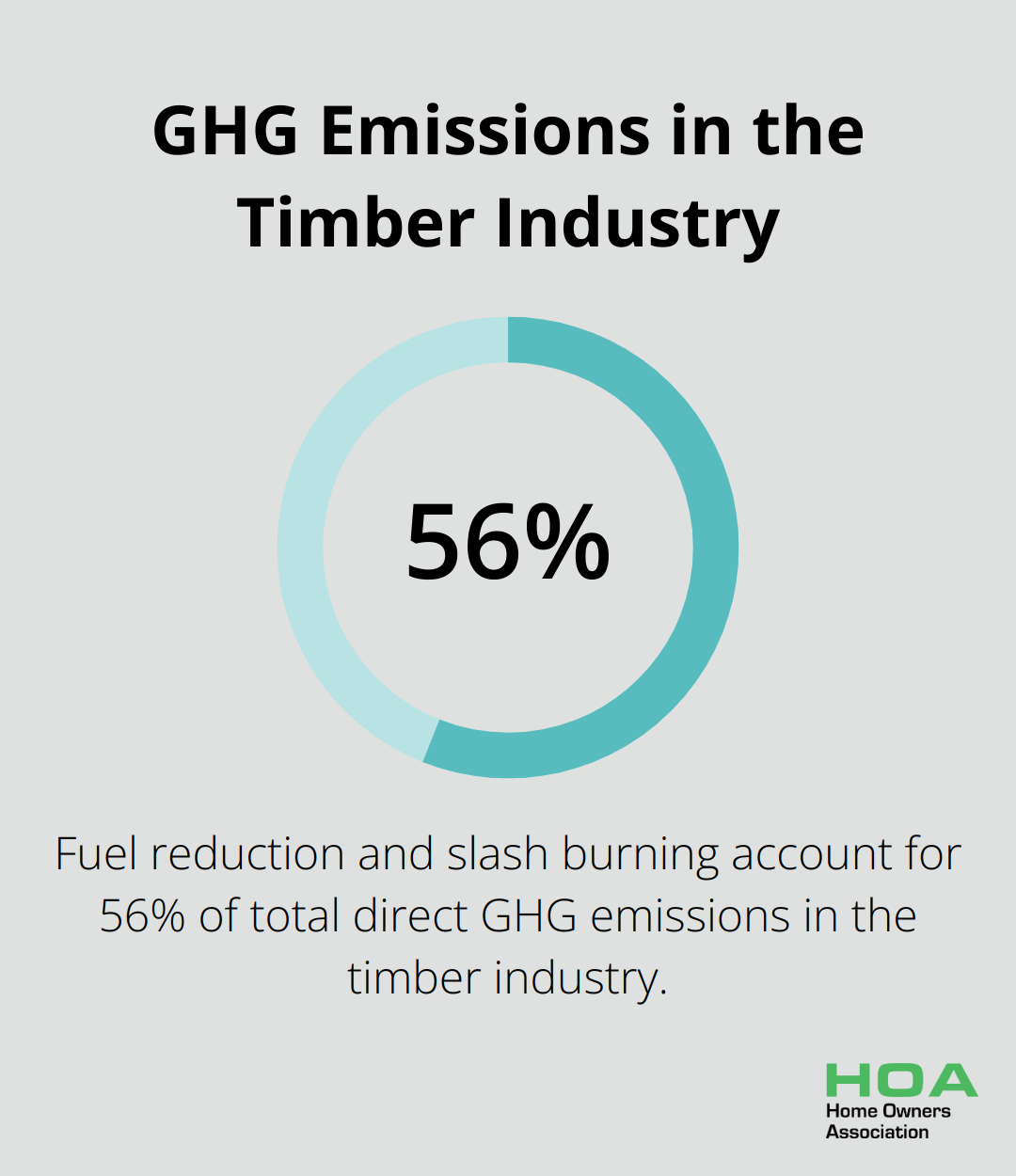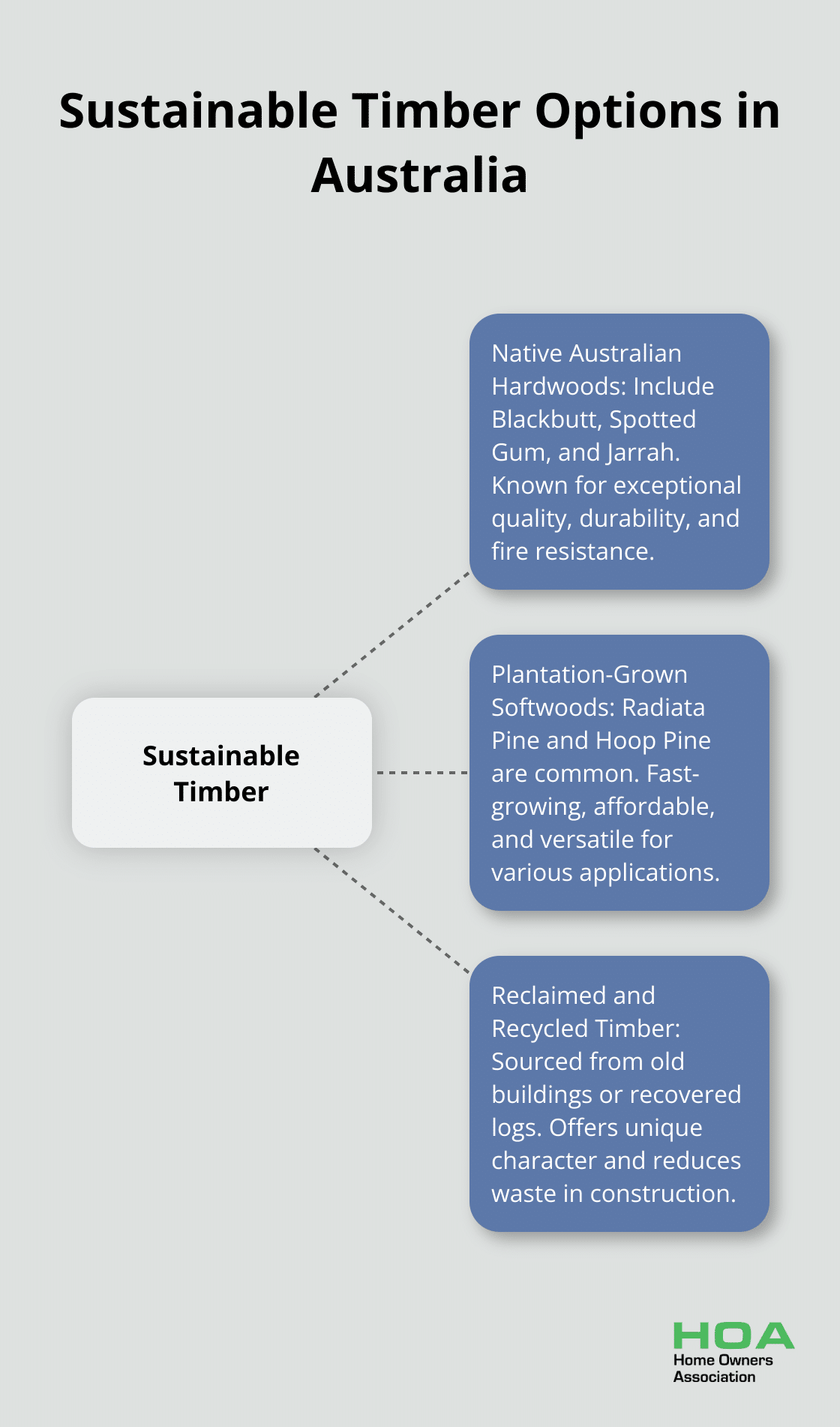
At Home Owners Association, we understand the importance of sustainable building practices in Australia. Choosing the right timber for your construction or renovation project can have a significant impact on the environment and your home’s longevity.
This sustainable timber guide for Australia will help you navigate the world of eco-friendly wood options. We’ll explore native species, plantation-grown alternatives, and certification standards to empower you in making informed decisions for your next home project.
What Is Sustainable Timber?
Definition and Importance
Sustainable timber comes from forests managed to preserve biodiversity, productivity, and ecological processes. Home Owners Association has observed a surge in interest for sustainable timber among Australian homeowners. This eco-friendly choice not only reduces environmental impact but also offers superior quality and durability for construction and renovation projects.
Environmental Benefits
The selection of sustainable timber significantly decreases your ecological footprint. Fuel reduction and slash burning were important contributors to total direct greenhouse gas (GHG) emissions accounting for 56% (32 kg m-3) of total direct GHG emissions in the timber industry. This highlights the importance of sustainable practices in the forestry sector.

Sustainable forestry practices also safeguard wildlife habitats and water quality. According to the Forest Stewardship Council (FSC), FSC-certified forests host 13% more bird species compared to conventionally managed forests. This preservation of biodiversity (a cornerstone of healthy ecosystems) underscores the importance of sustainable timber choices.
Sustainable Timber in Australian Construction
The use of sustainable timber in Australian building projects represents more than just an environmentally conscious decision-it’s a wise investment. Timber sourced from sustainably managed forests often exhibits superior qualities in terms of strength and longevity.
For example, Blackbutt (a popular sustainable Australian hardwood) is suitable for use in areas with specific bushfire protection requirements. BAL-29 is primarily concerned with protection of buildings from ember attack and burning debris ignited by wind-borne embers and radiant heat up to certain levels.
Economic Advantages
The choice of sustainable timber bolsters local economies. The Australian Bureau of Agricultural and Resource Economics and Sciences states that the forestry sector contributes over $23 billion to the national economy annually. Your decision to use sustainable Australian timber supports this critical industry and the communities that rely on it.
Furthermore, sustainable timber can enhance your property value. Research conducted by the University of Melbourne revealed that homes featuring sustainable elements (including responsibly sourced timber) commanded a price premium of up to 9.4% in the Australian market.
As we move forward, we’ll explore the various types of sustainable timber available in Australia, equipping you with the knowledge to make informed decisions for your next project.
Sustainable Timber Options in Australia

Native Australian Hardwoods
Australia offers a diverse range of sustainable timber options, each with unique characteristics suited for different applications. Native Australian hardwoods stand out for their exceptional quality and sustainability. Blackbutt provides good fire resistance and grows in the coastal regions of New South Wales and Queensland. This makes it an excellent choice for decking and structural applications in fire-prone areas.
Spotted Gum, another popular option, boasts a distinctive appearance and durability. Its natural oils provide resistance to decay and termites, which reduces the need for chemical treatments. Builders often use this timber for flooring, decking, and outdoor furniture.
Jarrah, native to Western Australia, captures attention with its rich, deep red colour and exceptional durability. Its natural resistance to rot and insects makes it particularly well-suited for outdoor applications.
Plantation-Grown Softwoods
Radiata Pine and Hoop Pine represent two of the most common plantation-grown softwoods in Australia. These fast-growing species offer a more affordable and readily available alternative to native hardwoods.
Radiata Pine (also known as Monterey Pine) grows widely across Australia. This versatile timber finds use in construction framing, furniture, and even paper production. When sourced from certified plantations, it becomes a sustainable choice that helps reduce pressure on native forests.
Hoop Pine, native to Queensland, has gained popularity as another plantation-grown option. Known for its straight grain and even texture, it suits interior joinery and furniture perfectly. The controlled cultivation of Hoop Pine ensures a steady supply without compromising natural habitats.
Reclaimed and Recycled Timber
The use of reclaimed and recycled timber has increased in Australia, offering a unique blend of sustainability and character. These materials often come from old buildings, bridges, or even sunken logs recovered from riverbeds.
Recycled timber not only reduces waste but also brings a piece of history into homes. It has become particularly popular for feature walls, exposed beams, and custom furniture. However, it’s important to ensure that reclaimed timber receives proper treatment and certification for structural use if intended for load-bearing applications.
Selecting Sustainable Timber
When choosing sustainable timber, consider factors such as durability, intended use, and local availability. Always look for certification from recognized bodies like the Forest Stewardship Council (FSC) or Programme for the Endorsement of Forest Certification (PEFC) to ensure your choice aligns with sustainable forestry practices. Forest managers and owners in Australia can choose to have their forests certified under the FSC and/or the PEFC.
The selection of sustainable timber not only contributes to the preservation of Australia’s unique ecosystems but also supports responsible forest management practices. As we move forward, it’s essential to understand how to verify the sustainability claims of timber products, which we’ll explore in the next chapter on certification and sourcing.
Navigating Timber Certifications in Australia
Forest Stewardship Council (FSC) Certification
The Forest Stewardship Council (FSC) certification sets global standards for responsible forest management. FSC-certified timber products come from forests that preserve biological diversity, benefit local communities, and maintain economic viability. As of 2023, over 1.2 million hectares of Australian forests hold FSC certification, covering both native forests and plantations.
Programme for the Endorsement of Forest Certification (PEFC)
The Programme for the Endorsement of Forest Certification (PEFC) endorses national forest certification systems that meet its sustainability benchmarks. In Australia, PEFC recognises the Australian Forest Certification Scheme, managed by Responsible Wood.
Responsible Wood Certification
Responsible Wood governs the Australian Forest Certification Scheme. Their certification ensures timber products originate from sustainably managed Australian forests that meet globally recognised standards. The Responsible Wood logo on products indicates certification throughout the entire supply chain, from forest to final product.
How to Verify Timber Sustainability Claims
Verifying sustainability claims requires attention to detail. Here are some practical steps:

- Look for certification logos: Search for FSC, PEFC, or Responsible Wood logos on timber products or packaging.
- Request documentation: Reputable suppliers should provide chain-of-custody certificates that trace timber back to its certified source.
- Use online verification tools: FSC and PEFC offer online certificate databases to verify certification claims.
- Consult experts: Professionals can help you understand certifications and connect you with trusted suppliers of certified sustainable timber.
- Scrutinise vague claims: Terms like “eco-friendly” or “green” without proper certification warrant further investigation.
The Importance of Certified Timber
Choosing certified timber supports sustainable forestry practices and often results in higher quality materials for your home. The use of certified timber (such as those with FSC or PEFC labels) ensures that your project contributes to responsible forest management.
Home Owners Association recognises the value of certified sustainable timber and can provide guidance on selecting the right materials for your project. Our expertise helps members make informed decisions that align with their sustainability goals and project requirements.
Final Thoughts
This sustainable timber guide for Australia provides homeowners with valuable insights into eco-friendly wood options. Certified sustainable timber offers high-quality materials for construction while supporting responsible forest management and preserving Australia’s unique ecosystems. The long-term benefits of choosing sustainable timber extend beyond individual properties, helping to maintain biodiversity and reduce carbon emissions.
Home Owners Association encourages Melbourne homeowners to make informed decisions about the materials they use in their projects. We offer expert guidance on sustainable timber selection and other aspects of home improvement. Our members benefit from access to trade pricing, discounts, and personalised advice to confidently pursue their home projects while adhering to sustainability principles.
For more information and support in your sustainable home improvement journey, visit the Home Owners Association website. Every choice matters in creating a more environmentally conscious built environment. Your decision to prioritise sustainable timber in construction and renovation projects contributes to a better future for Australia’s forests and the planet as a whole.





